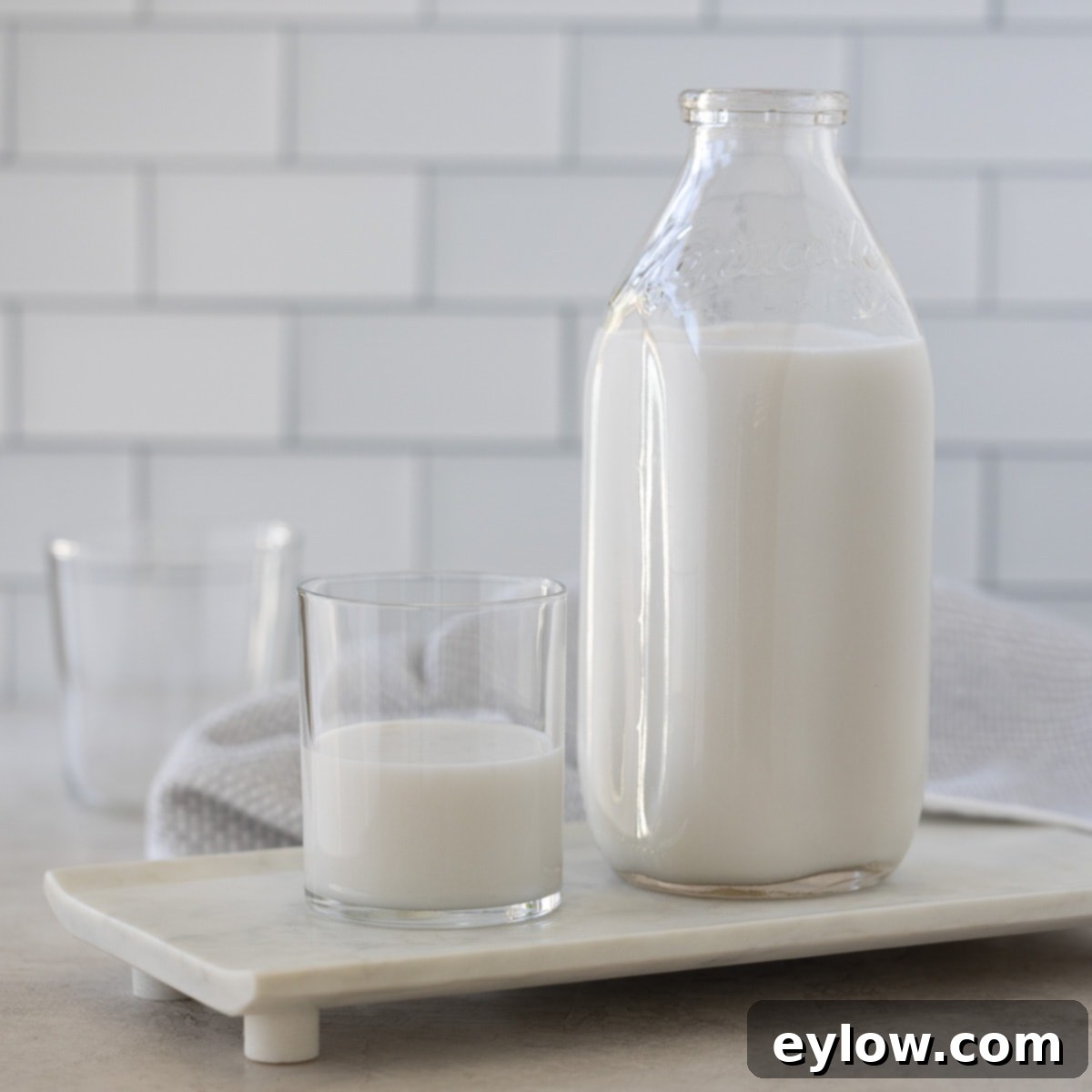Effortless Homemade Coconut Milk: Quick, Healthy & Customizable (Dairy-Free Recipe)
Discover the incredible simplicity and satisfaction of making your own coconut milk right at home. Far superior to most store-bought varieties, homemade coconut milk is not only quick and budget-friendly but also significantly healthier, completely free from the additives, gums, and preservatives often found in commercial products. All you need is a single can of full-fat coconut milk and some water, and within minutes, you can transform these two simple ingredients into a rich, creamy, and wonderfully versatile dairy-free milk. This fresh batch will elevate everything from your morning smoothies and coffee to savory soups and aromatic curries, offering a pure, unadulterated coconut flavor that’s hard to beat.
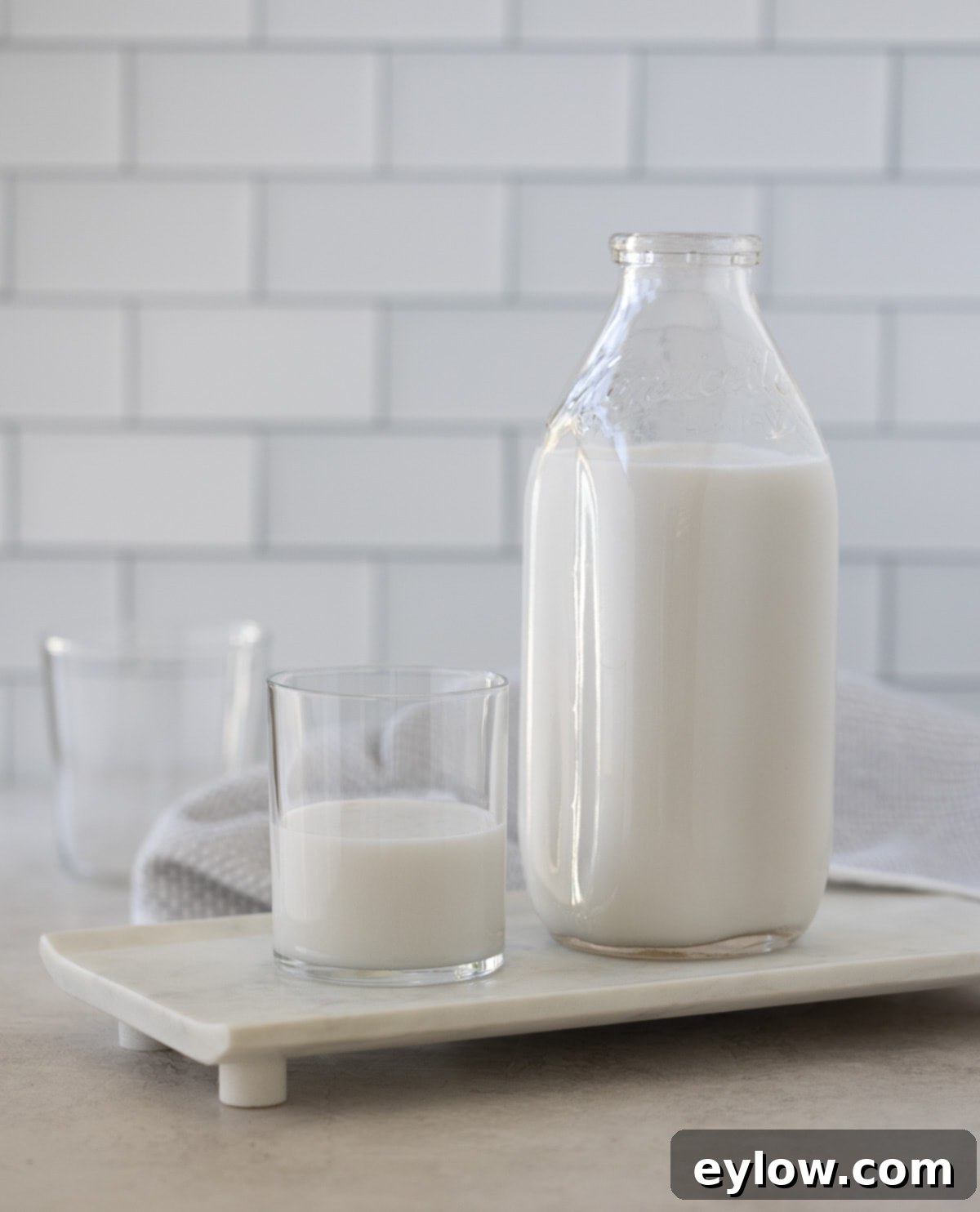
For those navigating dairy sensitivities or embracing a plant-based lifestyle, homemade coconut milk emerges as an exceptionally delicious and wholesome alternative. Assuming no coconut allergy, its naturally creamy texture and adaptable nature make it an indispensable pantry staple. The beauty lies in its effortless preparation: grab a can of full-fat coconut milk from your pantry, mix it with water, and in less than a minute, you’ll have fresh, additive-free coconut milk that often tastes superior and is always more economical than its store-bought counterparts. This DIY approach grants you complete control over the ingredients, ensuring a pure and natural product every time.
Beyond its health benefits, the ability to customize the thickness and flavor profile means you can tailor your coconut milk perfectly to any culinary need. Whether you desire a light, refreshing milk for everyday use or a rich, decadent cream for special recipes, homemade coconut milk delivers. It’s an empowering way to take charge of what goes into your food, providing peace of mind along with a delicious result.
[feast_advanced_jump_to]
Why You’ll Love Making Your Own Coconut Milk
Making coconut milk at home isn’t just a trend; it’s a smart, simple choice that offers a multitude of benefits. Here’s why you’ll quickly fall in love with this homemade staple:
- Just 2 Ingredients, Ready in 1 Minute – Forget complicated recipes and lengthy preparations. Our method requires only canned coconut milk and water, blended or stirred together in under sixty seconds. No special equipment, no extensive clean-up – just pure, fresh coconut milk.
- Pantry-Friendly Convenience – Canned coconut milk has a long shelf life, making it a perfect pantry staple. You can stock up and always have the base for fresh coconut milk on hand, ready whenever inspiration strikes for a smoothie, curry, or coffee creamer.
- No Mess, No Fuss – Unlike many homemade nut milks or recipes that start from dried coconut, this method completely eliminates the need for soaking, straining through cheesecloth, or dealing with pulpy residue. It’s a clean and simple process, saving you time and effort in the kitchen.
- Incredibly Versatile for Any Recipe – From sweet to savory, homemade coconut milk shines. Use it to create luscious smoothies, creamy dairy-free coffee, rich curries and soups, or in various baking applications. Its neutral yet distinctive flavor complements a wide range of dishes, making it a true kitchen chameleon.
- Significantly More Budget-Friendly – Regularly purchasing cartons of store-bought coconut milk can add up. By diluting a single can of full-fat coconut milk, you can produce a generous quantity for a fraction of the cost, making it a highly economical choice for health-conscious consumers.
- Additive-Free and Healthier – The biggest advantage is knowing exactly what’s in your milk – just coconut and water. You avoid unwanted thickeners, emulsifiers, and preservatives like carrageenan or guar gum, which can be problematic for some digestive systems. This results in a purer, cleaner, and often more digestible product.
- Customizable Thickness and Flavor – You have complete control over the richness. Adjust the water ratio to create a lighter, thinner milk for cereals or a thick, creamy consistency perfect for dessert recipes and richer sauces. This level of customization is impossible with pre-packaged options.
Once you experience the ease and superior quality of homemade coconut milk, you’ll wonder why you ever bought it from the store! For other delicious recipes that put canned coconut milk to good use, consider trying this flavorful coconut shrimp curry, or this comforting and creamy cauliflower soup.
Essential Ingredients for Homemade Coconut Milk
Crafting your own fresh coconut milk couldn’t be simpler, requiring just two core ingredients. The quality of these ingredients directly impacts the final taste and texture of your homemade milk, so choosing wisely is key.
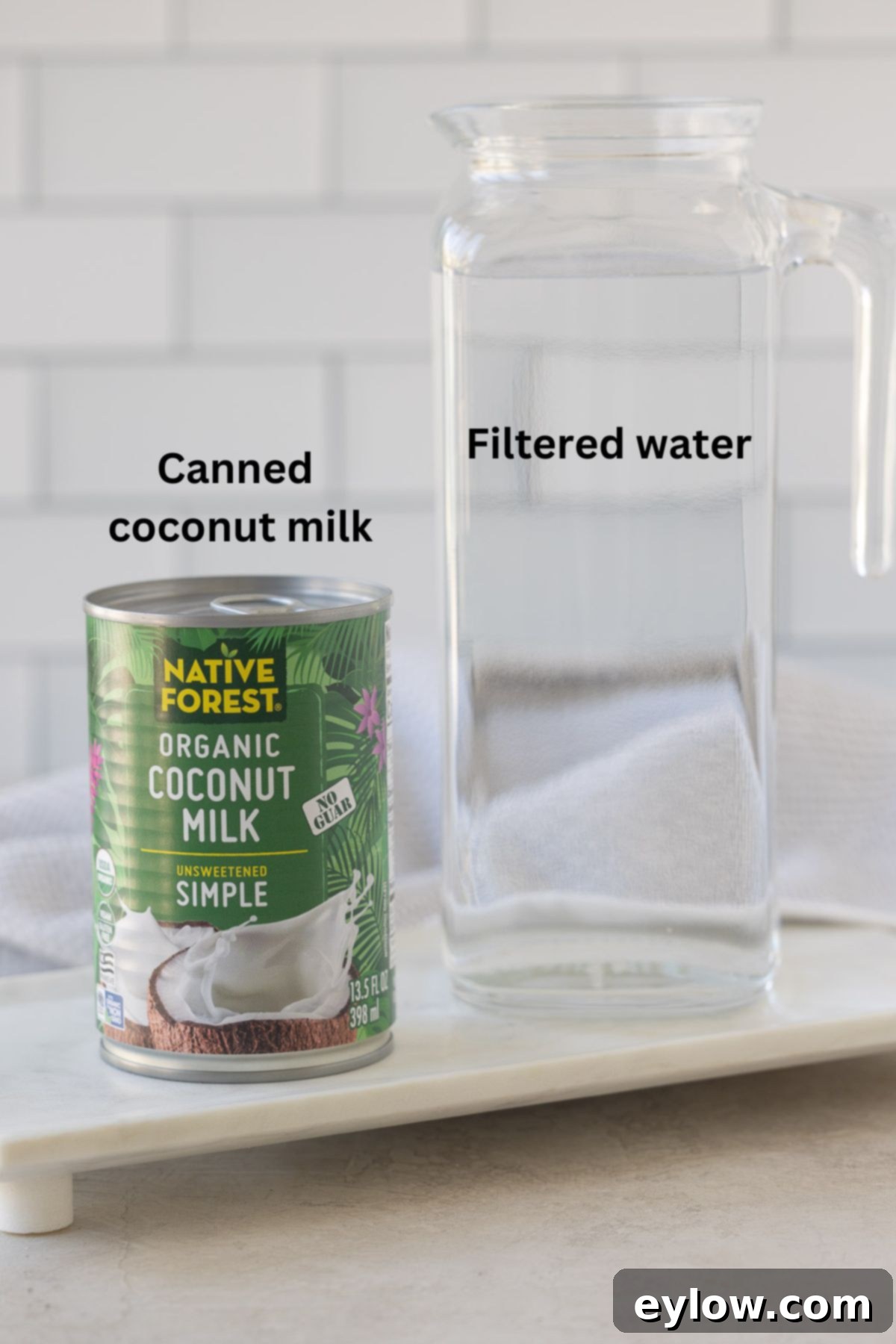
- Organic Full-Fat Canned Coconut Milk – This is the foundation of your homemade milk. Opt for organic, unsweetened, full-fat canned coconut milk for the creamiest, richest results. Full-fat versions yield a more luxurious texture when diluted, closely mimicking dairy milk. Look for brands that contain only coconut and water, avoiding those with added gums, stabilizers, or preservatives if possible. These cans store beautifully in your pantry, ready for whenever you need them. The richer the cream content, the better your homemade milk will be.
- Filtered Water – The choice of water is more important than you might think. Using good quality filtered water ensures the cleanest and purest flavor for your homemade coconut milk. Tap water can sometimes contain minerals or chlorine that might subtly alter the taste. For the healthiest and best-tasting homemade coconut milk, filtered water is always recommended.
Please refer to the recipe card below for precise measurements and ideal ratios to achieve your desired consistency. With these two simple, high-quality ingredients, you’re just moments away from a delicious and natural plant-based milk.
If you’re interested in exploring other quick and easy plant-based milk options, consider trying this fantastic hemp milk recipe, another dairy-free delight that can be prepared in under a minute.
Chef’s Tip: Understanding Coconut Milk and Its Benefits
Coconut milk, a beloved ingredient in cuisines worldwide, is traditionally crafted by blending the shredded white flesh of mature brown coconuts with water, then straining the liquid. The canned varieties you find in stores are typically much richer and thicker than the carton versions, which are often heavily diluted and contain many additives. By using full-fat canned coconut milk and diluting it at home, you gain complete control over the fat content and thickness. This allows you to create a lighter milk, akin to almond milk, perfect for everyday sipping, or a denser, creamier version ideal for cooking and adding richness to dishes. This customization is a key advantage, letting you tailor your milk precisely to your dietary needs and culinary preferences. For those mindful of saturated fat intake, understanding the fat content of coconut milk can help you make informed choices about dilution ratios.
Exciting Substitutions and Flavorful Variations
One of the joys of making your own coconut milk is the freedom to customize its flavor profile. Basic coconut milk is wonderful on its own, but with a few simple additions, you can transform it into something truly special. Here are some popular substitutions and variations to inspire you:
- Vanilla Coconut Milk – Elevate your coconut milk with a comforting hint of vanilla. Simply add a splash of pure vanilla extract (about ½ to 1 teaspoon per quart) or, for a more visual and aromatic experience, use vanilla bean paste. The paste not only imparts a richer vanilla flavor but also leaves those beautiful, tiny flecks of vanilla bean throughout your milk. This variation is fantastic in coffee, smoothies, or poured over granola.
- Sweetened Coconut Milk – If you prefer a touch of sweetness, there are many natural options. Stir in a few drops or a tablespoon of monk fruit syrup for a sugar-free natural sweetness that blends seamlessly into liquids. Honey is another excellent choice, adding a distinct floral note, while brown rice syrup or maple syrup can provide a deeper, more caramel-like sweetness. For powdered sweeteners, granulated or powdered monk fruit, erythritol, or stevia can also be easily blended in to achieve your desired sweetness level.
- Chocolate Coconut Milk – Indulge in a rich, dairy-free chocolate treat by whisking in unsweetened cocoa powder. Start with about 1 tablespoon per quart and adjust to your taste for a perfectly chocolatey and decadent beverage. A touch of sweetener (as mentioned above) can enhance the chocolate flavor. This is particularly delicious when served chilled or used in chocolate-flavored smoothies.
- Spiced Coconut Milk – For a warm and inviting twist, consider adding a pinch of ground cinnamon, nutmeg, or cardamom. These spices are especially lovely during cooler months or for enhancing a morning latte. A small amount of ginger powder can also add a subtle zest.
- Fruity Coconut Milk – While best made fresh for immediate consumption, you can blend in a small amount of fruit puree (like mango or berry) for an instant flavored milk. This is typically done directly in a smoothie or a drink, rather than flavoring the entire batch for storage.
Experiment with these variations to find your favorites. The ability to customize your coconut milk means endless possibilities for delightful beverages and culinary creations.
Simple Steps to Make Homemade Coconut Milk
Preparing fresh coconut milk at home is astonishingly easy and takes mere moments. Here’s a detailed guide to ensure perfect results every time:
- Prepare Your Ingredients: Ensure you have your can of full-fat organic coconut milk and filtered water readily available.
- Combine and Stir (for liquid coconut milk): If your canned coconut milk is already in a liquid state (which is common, though sometimes it separates into a cream layer and water), simply pour the entire contents of the can into a large container or a pitcher. Add the recommended amount of filtered water (as specified in the recipe card below) and stir vigorously with a spoon or whisk until thoroughly combined and smooth. This typically takes just 1 minute!
- Blending for Solidified Coconut Milk: It’s quite common for full-fat canned coconut milk to solidify, especially in cooler temperatures. Don’t worry, this is a good sign of high-quality coconut cream! To deal with solidified coconut milk, transfer the solid coconut cream and any liquid from the can into a high-speed blender. Add your filtered water. Secure the lid tightly and blend for just a few seconds on a low to medium setting until the mixture is completely smooth and creamy. Over-blending isn’t necessary, just enough to emulsify the fat with the water.
- Taste and Adjust: After mixing or blending, give your homemade coconut milk a taste. If you prefer a lighter consistency, you can gradually add a little more water. For a richer, creamier milk, use slightly less water initially. The beauty of homemade is this complete control over the final product.
- Yield: Following the ratios provided in our recipe card, you will typically yield approximately one quart (or one liter, which is about 4 cups) of fresh coconut milk. This is a perfect amount for daily use without having too much on hand.
That’s truly all there is to making fresh homemade coconut milk! It’s a simple, quick, and satisfying process that delivers a superior product. For more specific ratios of water to coconut milk and insights into variable fat grams, consult the “Customizing Coconut Milk” section further down this article.
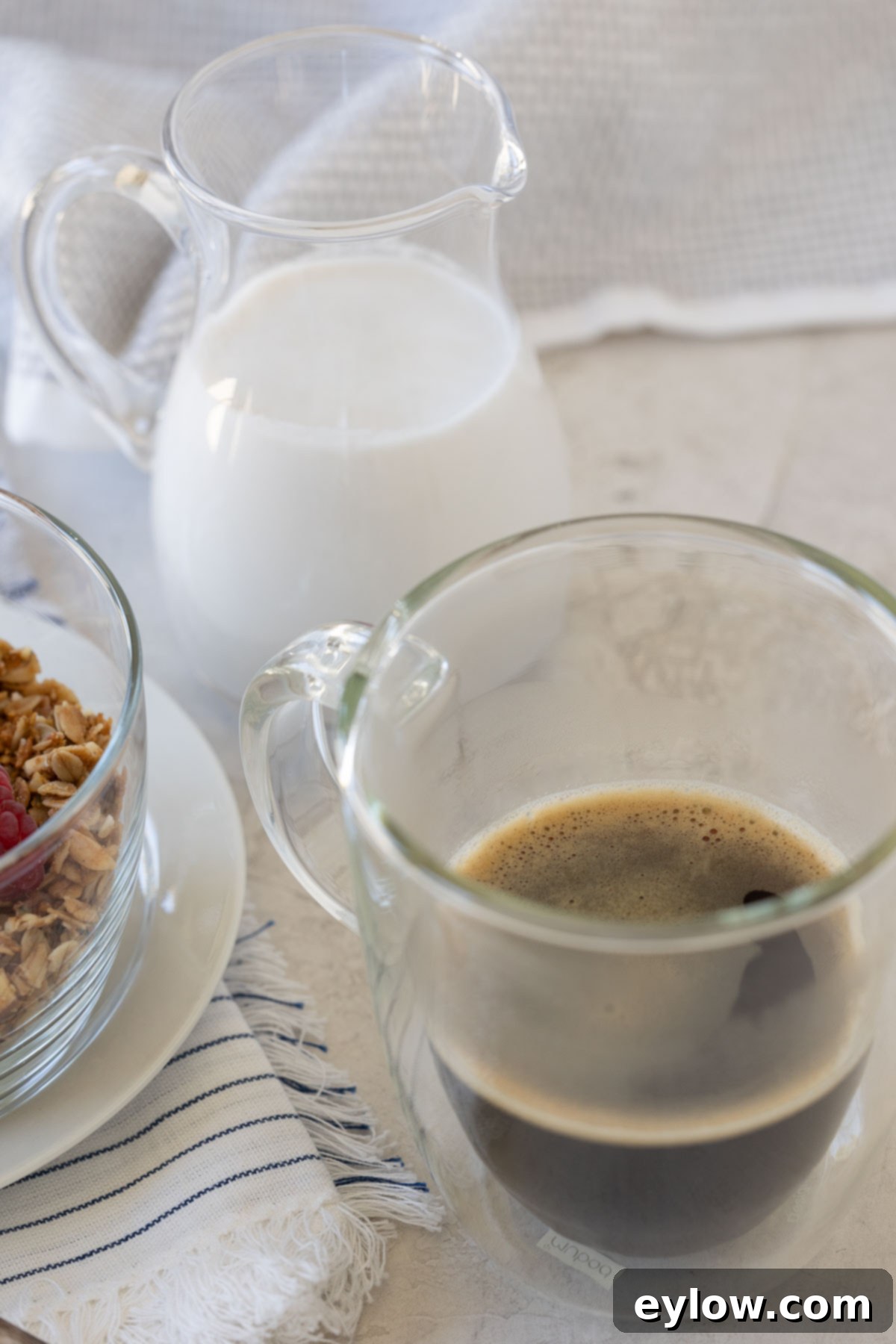
Exploring Coconut Milk from Coconut Milk Powder
While canned coconut milk is our preferred base for homemade versions, coconut milk powder offers another convenient, shelf-stable option, particularly useful for travel or emergency pantry situations. This powdered form is made from dehydrated coconut milk and is reconstituted by simply adding water. Most brands, when mixed as directed, typically provide about 3-4 grams of fat per cup, allowing for a lighter milk. Like with canned milk, you can easily adjust the water-to-powder ratio to achieve your desired level of creaminess or lightness. It’s incredibly handy for quick smoothies – just add the powder and water directly into your blender along with other ingredients.
However, the main consideration when using coconut milk powder is the presence of additives. It’s crucial to read labels carefully.
Chef’s note on Coconut Milk Powder Additives: Coconut milk powders almost universally contain tapioca maltodextrin. This ingredient serves as a thickener, stabilizer, and anti-caking agent, helping the powder mix smoothly and preventing clumping. While tapioca maltodextrin is gluten-free and generally recognized as safe, it is a processed carbohydrate derived from tapioca starch. It has a relatively high glycemic index, meaning it can cause a quick spike in blood sugar levels for some individuals. For this reason, and to ensure the purest product, I generally lean towards using organic canned coconut milk without any added gums or stabilizers when possible. However, for sheer convenience or when space is limited, coconut milk powder can be a viable option. For more comprehensive information on tapioca maltodextrin, its properties, and potential effects, refer to reputable health resources.
Always prioritize brands that list the fewest and most natural ingredients, even when choosing powdered options. The goal is to get as close to pure coconut goodness as possible.
Almond Milk Versus Homemade Coconut Milk: A Comparison
When it comes to plant-based milk alternatives, almond milk and coconut milk are two of the most popular choices. While both are dairy-free, they offer distinct nutritional profiles, flavors, and culinary applications. Understanding these differences can help you choose the best milk for your specific needs.
| Feature | Almond Milk (unsweetened) | Homemade Coconut Milk (diluted from canned) |
|---|---|---|
| Calories (per cup) | ~30–40 | ~50–100 (highly depends on dilution) |
| Fat (per cup) | 2–3 g (predominantly unsaturated) | 5–10 g (primarily saturated) |
| Protein (per cup) | 1–2 g | 0–1 g |
| Flavor Profile | Mild, subtly nutty, slightly watery texture in commercial versions | Creamy, distinct coconut-forward taste, rich mouthfeel when diluted properly |
| Best Culinary Uses | Ideal for smoothies, pouring over cereal, coffee (though can curdle), light baking, and as a neutral liquid base | Excellent for creamy curries, rich soups, luxurious sauces, dairy-free baking, hot chocolate, and as a coffee creamer for added richness |
Customizing Coconut Milk: Harnessing the Power of Dilution
One of the most significant advantages of making your own coconut milk from a can is the unparalleled ability to fine-tune the fat content and thickness. This level of customization allows you to create a milk that precisely matches your dietary preferences and the specific demands of your recipe. For example, by adjusting the water ratio, you can dramatically change its nutritional impact and texture:
- Richer, Creamier Milk: If you mix 1 (13.5 oz) can of full-fat coconut milk with 64 oz of filtered water, you’ll achieve a creamier consistency, resulting in approximately 10 grams of fat per 8-ounce serving. This ratio creates a luscious milk perfect for enriching savory dishes, making decadent desserts, or serving as a thick coffee creamer.
- Lighter, Everyday Milk: For a much lighter option, akin to a store-bought carton milk but without the additives, mix 1 (13.5 oz) can of full-fat coconut milk with a generous 128 oz of filtered water. This will yield approximately 5 grams of fat per 8-ounce serving, making it comparable to brands like Silk or So, but with a cleaner ingredient list. It’s ideal for cereal, lighter smoothies, or as a general dairy-free beverage. While it will be more fluid due to the absence of thickeners, its natural coconut flavor remains delightful.
This flexibility means you can prepare coconut milk that is as light as almond milk for daily consumption, or as rich as heavy cream for specific culinary applications. If you’re also interested in making another simple, additive-free plant-based milk, here’s my popular homemade almond milk recipe. It’s unstrained, wonderfully rich, and offers a creaminess that often surpasses commercial almond milk varieties.
Chef’s Tip: Beware of Hidden Additives in Commercial Coconut Milk
Many store-bought coconut milks, whether canned or in cartons, contain various stabilizers and thickeners designed to improve texture and prevent separation. Common culprits include carrageenan (derived from red algae) and guar gum (from guar beans). While these ingredients are generally deemed safe for consumption, some individuals report experiencing digestive upset, bloating, or inflammation. By making coconut milk at home, you completely bypass these potential additives, giving you absolute control over the purity of your ingredients. My personal preference is to use brands like Native Forest “Simple,” which explicitly state “no gums” on their labels, ensuring you get pure coconut and water. Always check the ingredient list diligently to ensure you’re choosing the cleanest possible base for your homemade creation.
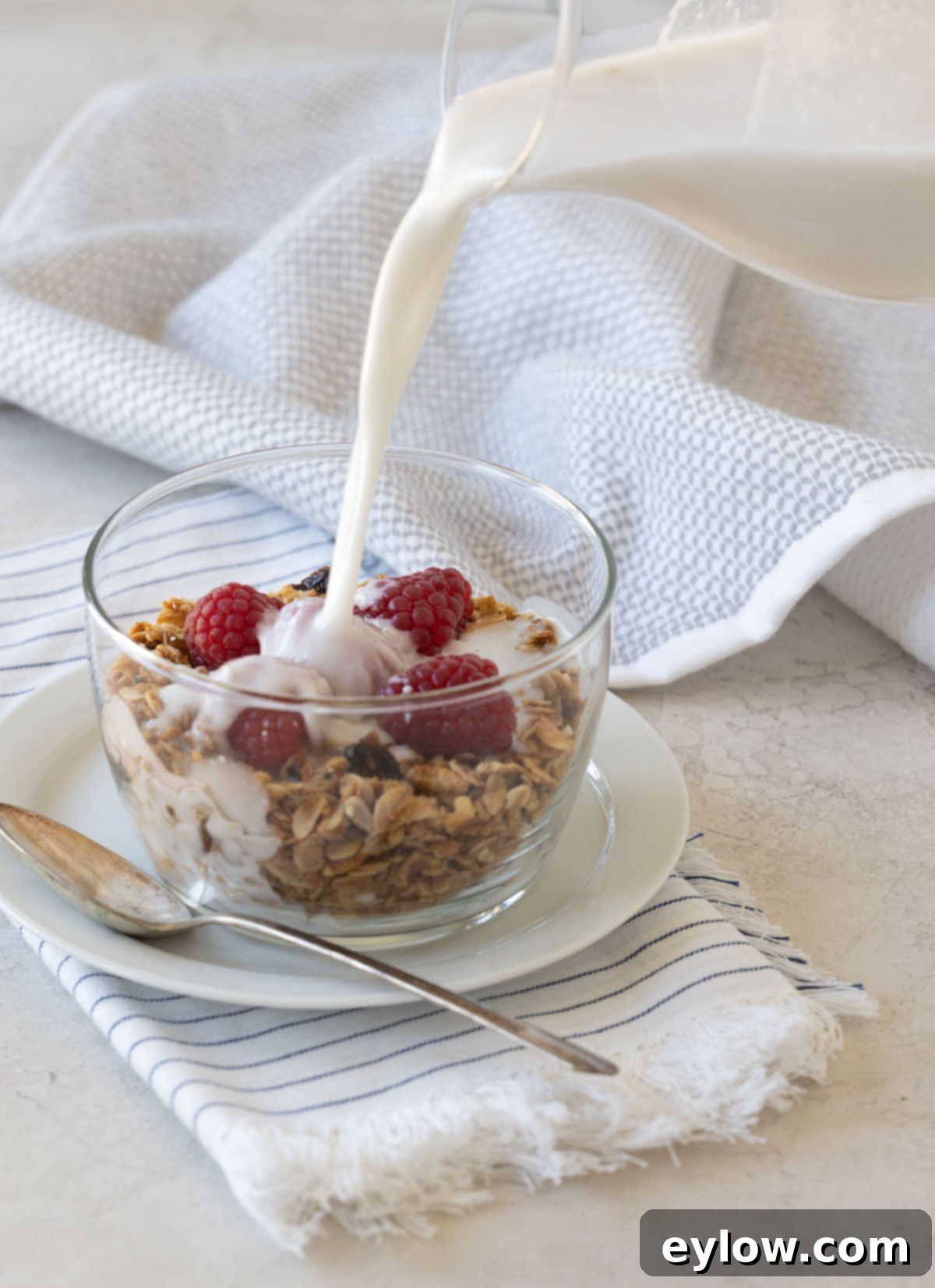
Delicious Ways to Enjoy Your Homemade Coconut Milk
The versatility of homemade coconut milk knows no bounds. Its creamy texture and mild, naturally sweet flavor make it a fantastic substitute for dairy milk in countless applications. Here are some of the best ways to incorporate your freshly made coconut milk into your daily routine and culinary adventures:
- Smoothies and Shakes – Replace traditional nut milks or cow’s milk with coconut milk for an incredibly creamy, dairy-free base. It adds a lovely tropical richness that pairs beautifully with fruits and greens. Try it in this refreshing strawberry banana smoothie.
- Coffee and Tea Creamer – Say goodbye to artificial creamers. Use homemade coconut milk directly in your coffee or tea. For an extra rich and thick creamer, simply dilute your canned coconut milk with less water, creating a more concentrated, luscious pour. It’s a wonderful way to enjoy a dairy-free latte or a creamy cup of chai.
- Hearty Breakfast Bowls – Pour it generously over your morning oatmeal, porridge, or a bowl of homemade granola topped with fresh berries. Its creamy texture adds a satisfying element that will keep you full and energized.
- Soups and Stews – Stir homemade coconut milk into pureed vegetable soups to add a velvety texture and a subtle, balancing sweetness. It’s especially transformative in curried soups or this delightful creamy fennel soup recipe with white beans.
- Chia Pudding and Overnight Oats – Substitute almond milk or other plant milks with coconut milk for a richer, more indulgent chia pudding or overnight oats. The coconut flavor blends wonderfully with various toppings and fruits.
- Baking and Desserts – Use it as a direct swap for dairy milk in many baking recipes, from cakes and muffins to puddings and custards, for a dairy-free twist. Its richness can also enhance the texture of homemade ice creams.
- Savory Sauces and Curries – This is where coconut milk truly shines! It forms the backbone of countless Thai, Indian, and other Asian-inspired curries and sauces, providing a depth of flavor and a creamy consistency that is unmatched.
Essentially, homemade coconut milk works beautifully almost anywhere you would traditionally use dairy milk – whether served warm or chilled, in sweet or savory dishes. Its natural, pure taste is a game-changer for plant-based cooking and healthy eating.
Proper Storage for Fresh Homemade Coconut Milk
Ensuring your homemade coconut milk stays fresh and delicious is key to enjoying its benefits. While it lacks the preservatives of store-bought versions, with proper storage, you can keep it in excellent condition for several days.
Homemade coconut milk typically lasts for about 3-4 days when stored in the refrigerator. To maximize its quality and shelf life, always keep it in a tightly sealed container. Glass jars are often preferred over plastic as they can help maintain freshness and prevent any absorption of flavors or odors.
Here are a couple of essential tips for maintaining its quality:
- Shake or Stir Before Use: It’s completely normal for homemade coconut milk to separate as it sits in the refrigerator. The fat (coconut cream) will naturally rise to the top and solidify, especially if it’s a rich mixture. Simply give the container a good shake or stir vigorously before each use to re-emulsify the milk back to its creamy consistency.
- Sniff & Taste Test: Your senses are your best guide. If the coconut milk develops a sour smell, an off-putting tang, curdles unexpectedly (beyond normal separation), or turns a grayish/cloudy color, it’s a clear indication that it has gone bad. In such cases, it’s best to discard it and prepare a fresh batch.
Important: Do not store homemade coconut milk at room temperature, as this will drastically reduce its shelf life and increase the risk of spoilage.
Freezing Coconut Milk: For longer storage, homemade coconut milk freezes beautifully! You can freeze it in airtight containers, leaving a little headspace for expansion, or in ice cube trays for convenient portioning. Once frozen solid in trays, transfer the cubes to a freezer-safe bag or container. It can be stored in the freezer for up to 2 months. To use, thaw overnight in the refrigerator. You may need to whisk or blend it briefly to restore its creamy texture after thawing, as some separation is natural.

Frequently Asked Questions About Homemade Coconut Milk
Absolutely, yes. Making homemade coconut milk from a can of full-fat coconut milk is almost always more economical than consistently buying cartons of pre-made coconut milk from the store. While the cost per serving is typically just a few cents less, the main advantage is the shelf-stability of canned coconut milk, ensuring you always have a fresh supply in your pantry without needing frequent trips to the grocery store. Coconut milk powder offers another budget-friendly and convenient option if you prioritize shelf life and portability.
In many aspects, yes. Homemade coconut milk provides you with unparalleled control over the ingredients, ensuring there are no unwanted additives, gums, or stabilizers. You can also perfectly adjust the thickness and richness to your preference by varying the dilution ratio. By choosing an organic, high-quality canned coconut milk that contains only coconut and water (like the brands I personally recommend and use), you guarantee the cleanest, purest, and often best-tasting base for your milk. This superior quality often translates to better flavor and digestibility.
Yes, it is possible to make coconut milk from dried coconut flakes or shredded coconut, but it involves a more labor-intensive process. This method typically requires soaking the dried coconut in hot water to soften it, then thoroughly pureeing it in a high-speed blender, and finally straining the mixture through a cheesecloth to separate the milk from the pulp. While it yields a fresh product, it also creates leftover pulp that you’ll need to decide what to do with. Using canned coconut milk is significantly faster, easier, and less messy for everyday homemade coconut milk.
Absolutely! Homemade coconut milk freezes exceptionally well. For best results, freeze it in airtight containers, leaving a bit of space at the top for expansion. Alternatively, you can freeze it in ice cube trays for convenient, pre-portioned amounts. It can be safely stored in the freezer for up to 2 months. When you’re ready to use it, simply thaw it overnight in the refrigerator. You may find that it separates slightly after thawing, but a quick whisk or blend will restore its creamy, smooth consistency.
For the highest quality homemade coconut milk, always choose organic, unsweetened, full-fat canned coconut milk. Critically, examine the ingredient list. Look for brands that list only “coconut” and “water” (or coconut extract and water). Avoid cans that contain added gums (like guar gum, xanthan gum), emulsifiers, or other stabilizers, as these can impact the taste, texture, and digestibility of your homemade milk. Brands like Native Forest “Simple” are excellent choices that pride themselves on additive-free products.
Yes, absolutely! It’s very common and perfectly normal for full-fat canned coconut milk to solidify, especially in cooler temperatures. This is a sign of high-quality coconut cream and fat content. Simply scoop out the solid portion along with any liquid into your blender, add water, and blend until smooth and creamy. The heat from blending (or briefly warming the can in hot water) will help it liquefy and mix uniformly.
Explore More Dairy-Free Milk Recipes and Culinary Ideas
Our journey into homemade plant-based milks doesn’t end with coconut milk. There’s a whole world of delicious and nutritious dairy-free options waiting to be explored. Homemade milks offer superior flavor, freshness, and control over ingredients, allowing you to tailor them perfectly to your dietary needs and taste preferences.
Don’t forget to use your freshly made coconut milk in a variety of recipes! It’s especially delightful in a range of smoothie recipes – visit our dedicated page for a wealth of ideas to get you started. Its creamy texture also works wonders in savory dishes, adding depth and richness. For instance, it’s absolutely delicious in this comforting sheet pan roasted red pepper soup, where it provides a smooth, velvety finish.
Expand your homemade milk repertoire with these other fantastic dairy-free recipes:
- How to Make Homemade Almond Milk
- Homemade Pumpkin Seed Milk (Dairy-free)
- Cashew Milk Recipe
- Hemp Mylk (hemp milk recipe)
⭐️ We’d Love to Hear From You!
If you take the plunge and make your own homemade coconut milk using this recipe, please don’t hesitate to share your experience in the comments below. Your feedback means a lot to us, and we truly enjoy hearing how these recipes work out for you. If you loved how easy and delicious it was, please consider leaving a 5-star rating! Your ratings and reviews are incredibly helpful to other readers searching for reliable and tasty plant-based options.
📖 Recipe: Quick Homemade Coconut Milk

Quick Homemade Coconut Milk
Sally Cameron
Pin Recipe
Ingredients
- 13.5 ounce can organic full-fat coconut milk
- 20 ounces filtered water (approximately 2 ½ cups for a creamy consistency)
Instructions
-
For Liquid Coconut Milk: If your canned coconut milk is already in a liquid state, simply shake the can well to combine any separated cream and water. Pour the entire contents into a tall container or a large mixing cup. Add the measured filtered water and stir vigorously with a whisk or spoon for about one minute until fully smooth and combined.
-
For Solidified Coconut Milk: If your canned coconut milk has solidified (which is common for full-fat varieties), scoop the solid coconut cream and any liquid into a high-speed blender. Add the measured filtered water. Secure the lid and blend on a low to medium setting for a few seconds until the mixture is completely smooth and creamy, with no lumps remaining.
-
Taste and Adjust: Taste your freshly made coconut milk for your preference. If you desire a thinner, lighter consistency, gradually add a little more filtered water. If you prefer it richer and creamier, note to use slightly less water next time. Pour into a glass jar or airtight container, cover, and refrigerate.
Notes
Adjusting Fat Content: To reduce the fat per serving, simply dilute the milk further by adding more water, or consider starting with a “light” canned coconut milk, although full-fat generally yields better flavor and creaminess when diluted.
Flavor Variations:
- Vanilla flavored: For a delightful vanilla coconut milk, stir in ½ to 1 teaspoon of pure vanilla extract or vanilla bean paste. The paste offers a richer flavor and beautiful flecks of vanilla bean.
- Sweetened: To sweeten your milk naturally, try monk fruit syrup for a sugar-free option that blends effortlessly. Alternatively, you can use a touch of honey (which adds a distinct flavor), brown rice syrup, or maple syrup. Powdered or granulated sweeteners like monk fruit, erythritol, or stevia also work well.
- Chocolate: Whisk in 1-2 tablespoons of unsweetened cocoa powder for a delicious chocolate coconut milk. Adjust to taste, and consider adding a sweetener if desired.
Specific Ratios for Lower Fat Levels:
- Medium-Fat Option: Mix 1 (13.5-ounce) can of full-fat coconut milk with approximately 64 ounces (8 cups) of filtered water. This yields around 9 servings, each with about 10 grams of fat per 8-ounce serving. This is a creamy, yet not overly rich, everyday option.
- Low-Fat Option: For a very light coconut milk, similar to some store brands but without additives, mix 1 (13.5-ounce) can of full-fat coconut milk with 128 ounces (16 cups) of filtered water. This provides approximately 17 servings, each containing about 5 grams of fat per 8-ounce serving. Note that it will be more fluid due to the absence of thickeners found in commercial products.
